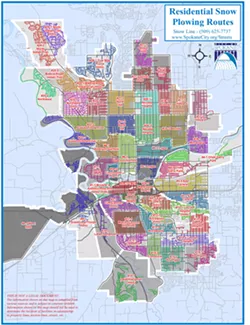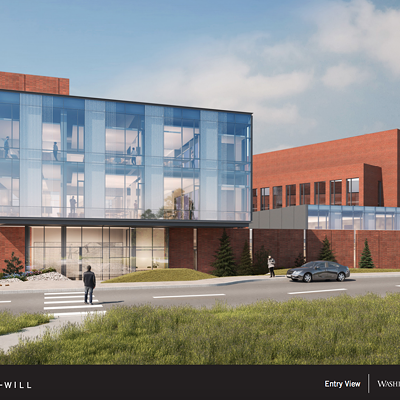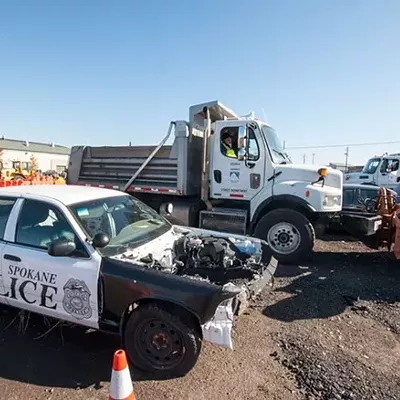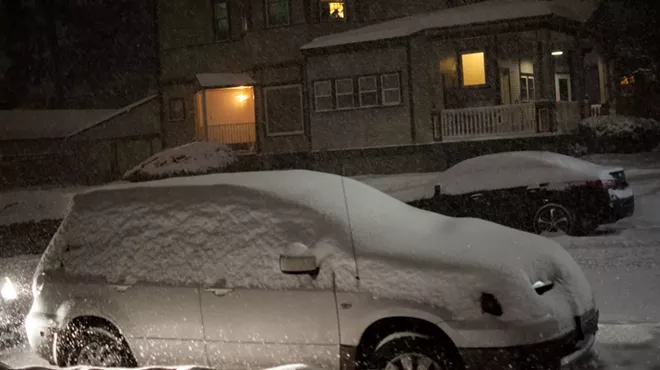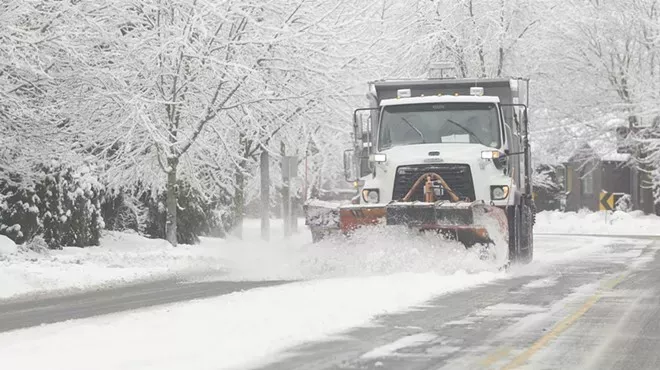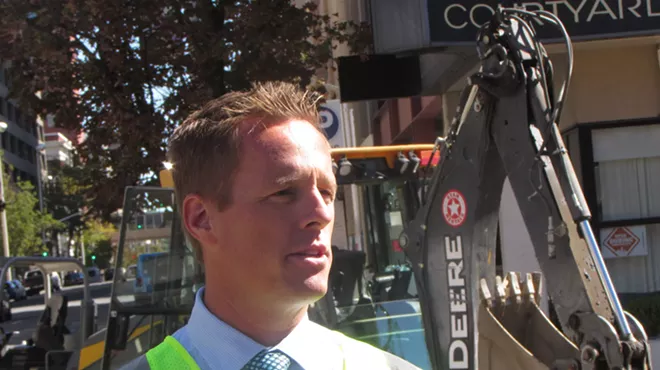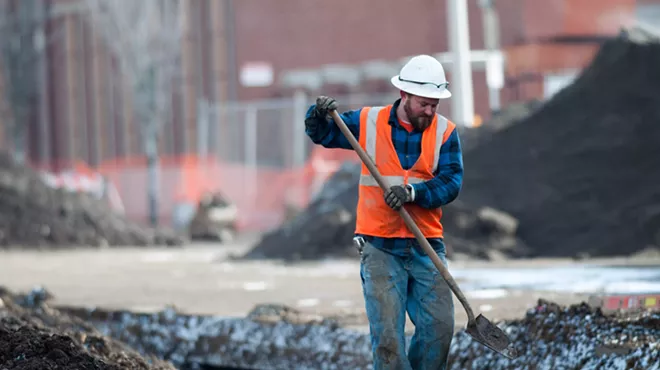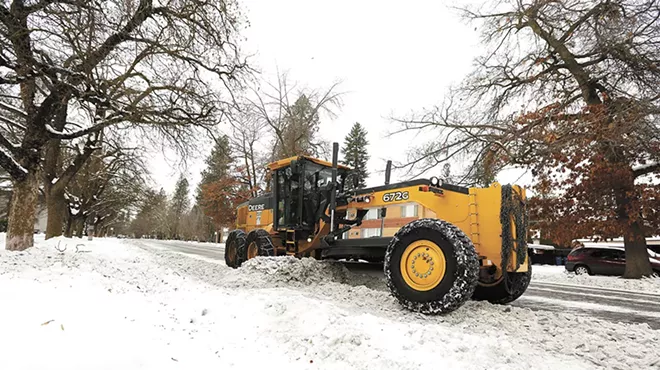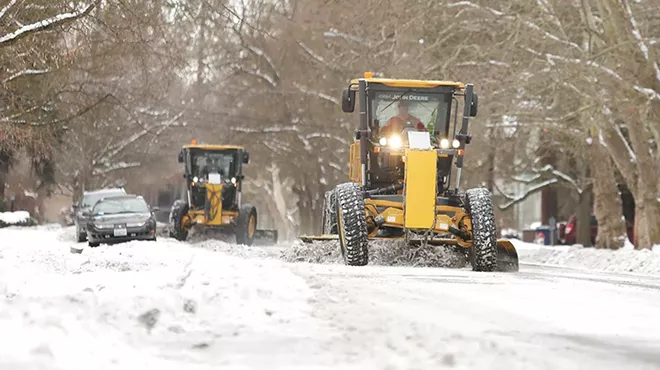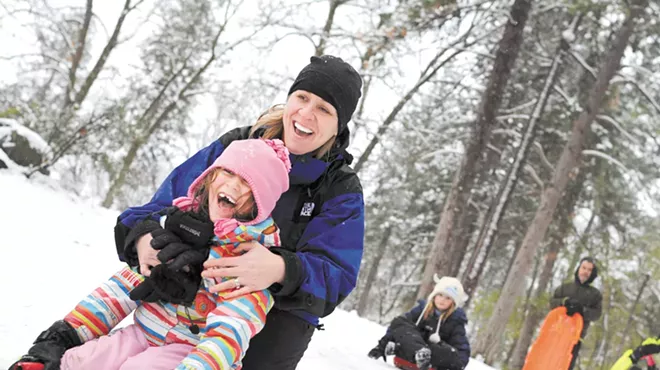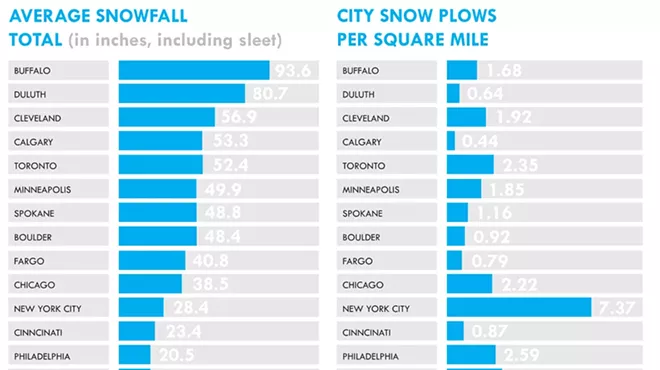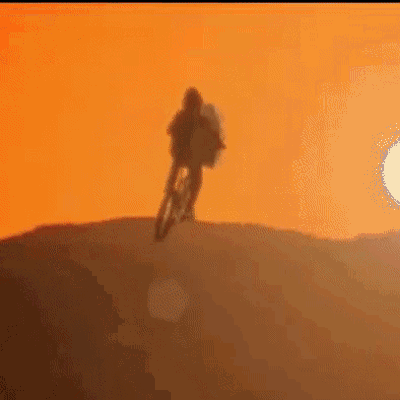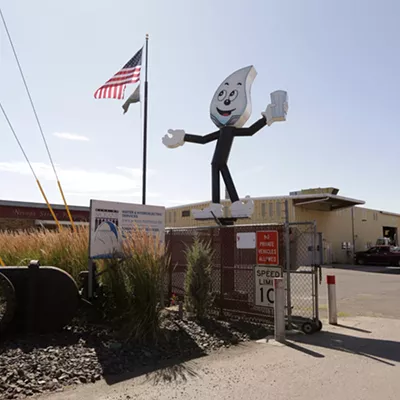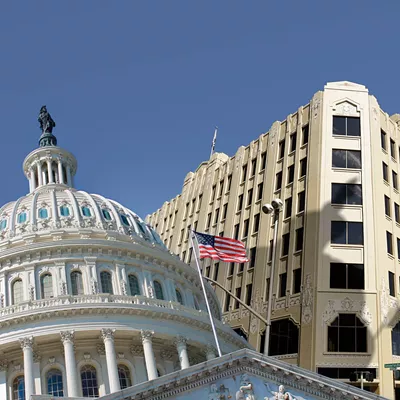Monday, October 16, 2017
Spokane's new snowplow plan: Faster plowing, narrower streets, bigger berms
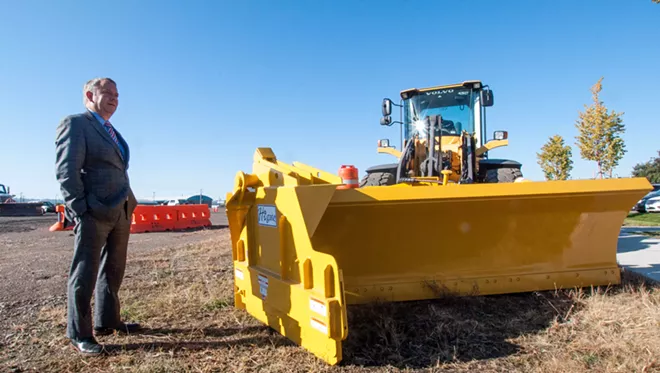
Daniel Walters photo
Mayor David Condon stands in front of a front-end loader equipped with a gate that can drop down to prevent snow from being plowed in front of driveways.
Winter is coming to Spokane.
And if it's anything like last winter, it will be a snowy hell of fury and flurries. Last winter, complaints abounded about the city's snow response, including objections from the neighborhoods, downtown businesses and school districts.
In fact, last year, in the middle of snow season, then-Streets Director Mark Serbousek was fired from his position.
But with new Streets Director Gary Kaesemeyer in place, the Condon administration and City Councilwoman Amber Waldref have been pushing to try to reinvent the way the city gets plowed.
They even put out a survey in April to get feedback from Spokane residents.
Today, the city officially outlined their new snow-plowing strategy at a press conference in front of a new front-end loader snowplow.
"The heart of our new plan is really pretty simple," Condon said at today's press conference. "More plowing in more areas sooner."
And so far, at least, they're doing it without spending extra money. Instead, they're shifting staff from other departments to man snowplows during the snow season, and changing the order of planned fleet replacement to buy new equipment.
"We've heard you, and we're going to tackle snow differently as a result," Condon says.
Here are the highlights:
Residential plowing will start earlier, take place more often and create bigger berms
The moment it snows — even if it's just an inch or two — snowplows will start plowing every residential street during the day. That way, things like routes to schools, bus stops and hospitals are more likely to be cleared more often.
And when there's a really big snow dump — a "snow event" — the city will bring in the big guns and move to 24/7 plowing.
The downside?
"You have the trade-off because we'll now be plowing earlier, which will cause larger berms," Condon says. "Where before, you know, we would allow it [to remain unplowed and] in many cases you'd have warmups right after
Plowing will happen faster
It won't just be traditional snowplow drivers driving plows anymore. The city will borrow staff from the water and wastewater departments — as well as the signs and markers crew and the signaling street department — and will put them behind the wheel.
All that redirected staffing means the city will be able to complete a full-city plow in three days instead of four. That also means, however, that other work in the city may not get done as quickly.
Driveways won't always be plowed in this year, thanks to some new equipment
"In the early '90s, we had a gate that dropped down at the driveways," Serbousek told the Inlander back in 2009. The gate would push the snow past the driveway entrances, and then raise up to release the snow as it passed.
Budget cuts and city expansions meant that the gates were abandoned, but now they're back: Thanks to rejiggering the fleet replacement budget, the city now has seven pieces of equipment — four new front-end loaders and three graders — with these types of gates.
However, most snowplows will still lack this feature, and increased frequency of residential plowing means you'll still often have to shovel a driveway berm to get your car out some mornings.
"With only this limited amount of the high-lift gates we have, we're not going be able to get to every driveway [during every snowstorm] this winter," Kaesemeyer says.
Still, the city will rotate the equipment with the gates between different areas of the city. Ideally, every neighborhood will get to experience the thrill of a snowplow that doesn't dump snow in front of driveways.
Sidewalks won't get plowed in as often, but streets will become narrower as a result
It's long been one of the biggest problems during big snowfalls: Property owners are required to shovel the driveways in front of their houses, but snowplows often inadvertently dump huge berms directly onto sidewalks close to streets.
The proposed solution? Plow snow farther away from the sides of streets. Big snow berms will pile up on the shoulders of the road, instead of on top of the sidewalks. The downside, of course, is that streets will become narrower as a result.
You might start getting charged for failing to shovel sidewalks out front
Property owners will still be required to shovel 3-foot-wide paths through the sidewalks in front of their houses. Director of Code Enforcement Heather Trautman says the city has been considering the option of charging "the property owner for the work if they don't respond to the notices they receive."
In the upcoming months, Trautman says, the city council will discuss this possibility. Elderly or disabled neighbors who might have trouble clearing their driveways or sidewalks will be able to call 311 to get assistance.
Prepare for major new parking rules
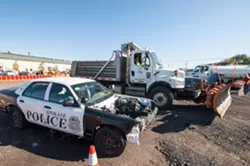
Daniel Walters photo
A training course at the city' of Spokane's fleet maintenance facility allows new snowplow drivers to practice navigating big snowplows between tight spaces.
This year, instead of requiring everyone to move their cars to one side of the street during a snow event, the city wants you to only park on the odd side of the street during the entire snow season, from Nov. 15 to March 15.
After all, a big problem with snowplowing last winter was all of the cars parked in the way of the plows.
Rules are even tougher downtown (from Maple to Division and I-90 to the Spokane River.) On snowy days, cars aren't allowed to be parked on the street at all from midnight to 6 am.
And if you have an RV or a boat trailer? Those will need to be moved completely off of all streets for the entire snow season.
"Unfortunately, we might see some of those vehicles moved or towed in November if they're not able to apply," says Trautman.
Residential plow routes have been reconfigured with new names; Browne's Addition won't have to wait until the very end to get plowed
The old snowplow route map has been reconfigured to be more easy-to-understand and neighborhood-centric.
The narrow streets of Browne's Addition meant that the city often delayed plowing the neighborhood after each snowstorm until the very end of the plowing cycle. That won't happen this winter. By attaching a smaller plow to a pickup truck, the street team will be able to more nimbly clear the neighborhood's tight-squeeze streets.
Tags: News , Spokane , snowplows , new plan , David Condon , Gary Kaesemeyer , Streets Director , berms , sidewalks , Browne's Addition , Image

